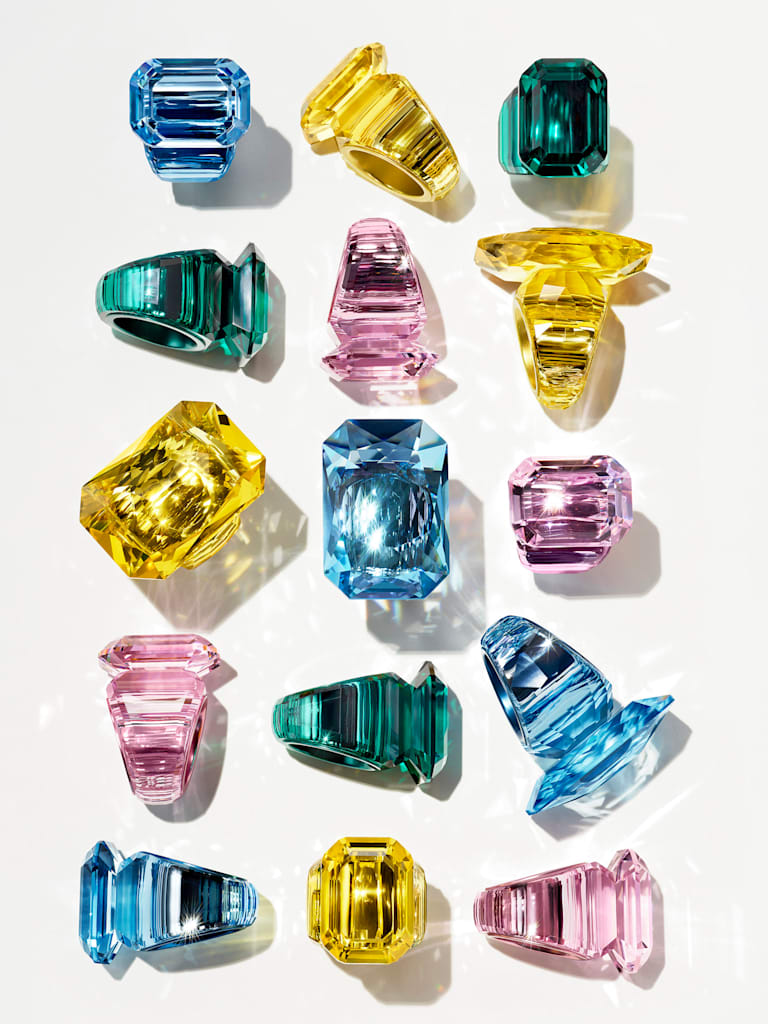Global businesses like ours have a duty to reinvent the way they operate. If we act quicky and boldly, we can still lessen the worst of the expected impacts. That is why we are working hard to reduce our waste and our emissions, and continually seeking to implement measures that meaningfully cut our environmental footprint.
Discover more below about the three pillars of our sustainability strategy that focus on our planet: Greenhouse Gas Emissions; Conscious Materials; and Waste & Circularity.

Emissionen reduzieren
Title:Scope-1- und Scope-2-Reduzierungspläne:
• Investitionen in unsere Energieinfrastruktur, unter anderem in erneuerbare Energien, Photovoltaik, Wärmepumpen, Wasserstoffinfrastruktur und Speichermöglichkeiten, um unsere Energieeffizienz noch weiter zu verbessern.
• Einführung der Elektrifizierung, wo möglich, einschließlich für unsere Glasschmelzöfen.
• Ausgleich des übrigen Energieverbrauchs mit Zertifikaten für erneuerbare Energien.
Scope-3-Reduzierungspläne:
• Erhöhung der Materialeffizienz unserer Produkte und Wechsel von primären auf recycelte Metallquellen.
• Durchführung einer globalen Hybrid-Arbeitsweise (dies umfasst die Arbeit von zu Hause an einigen Tagen).
• Zusammenarbeit mit unseren Lieferanten, um mehr erneuerbare Energien in ihren Produktionsprozessen zu fördern.
• Schritt für Schritt von der Luft- zur See- und Bahnfracht wechseln.

Energieeffizienz
Title:Im Rahmen unserer Bemühungen, unsere Energieeffizienz steigern, unsere Treibhausgasemissionen zu verringern und wo immer möglich auf erneuerbare Energiequellen zu setzen, wollen wir den Einsatz von Photovoltaik an unseren Produktionsstandorten und Verwaltungsbüros ausweiten. In Wattens in Österreich haben wir unsere zweitgrößte Photovoltaikanlage gebaut, die eine Leistung von 300 Kilowattpeak (kWp) auf einer Fläche von 1.600 m2 vorweist. Wir haben in der Vergangenheit eine Anlage mit 1400 kWp an unserem Fertigungsstandort in Thailand und eine Dachsolaranlage zur Warmwasserbereitung in Indien errichtet. Weitere Photovoltaikanlagen sind zudem bereits in Planung.
Designstudie zu Glasschmelzöfen
Gemeinsam mit einem multinationalen Glasunternehmen, das sich auf Glas und Glaskeramik spezialisiert, haben wir eine Designstudie gestartet. In dieser wurde überprüft, ob unsere Aggregate ausschliesslich mithilfe von elektrischer Energie geschmolzen werden können. Die Studie zeigte, dass Aggregate zu 90 % mit Strom geschmolzen werden können. Das bedeutet, dass wir den Einsatz von Gas während dieses Prozesses erheblich reduzieren können. Wir stehen kurz vor der Implementation eines Konzepts für die restlichen 10 % des Energieverbrauchs. Haben wir dies erstmal erreicht, werden wir große Mengen an Aggregaten mit 100 % erneuerbarer Energie schmelzen können. Das ist ein großer Meilenstein auf unserem Weg hin zur Reduzierung des CO2-Fußabdrucks unseres Kristalls.

Swarovski Stores
Title:Während den Materialien, aus denen die Stores gebaut werden und dem Energieverbrauch, den die Stores aufweisen, viel Aufmerksamkeit geschenkt wird, erhalten die erheblichen Abfallmengen, die bei Ladenumzügen, Schließungen und Renovierungen anfallen, kaum Beachtung. Wir haben mehrere Pilotprojekte durchgeführt, um das Potenzial für das Recycling alter Elemente unserer Ladenarchitektur zu untersuchen. Bis jetzt haben wir mehr als 100 Tonnen Material über unsere Handelspartner recyceln können. Wir sind davon überzeugt, dass es unsere Verantwortung ist, am Ende des Lebenszyklus eines Stores nachhaltig zu handeln und nicht einfach zur großen Eröffnung oder zum täglichen Geschäftsbetrieb überzugehen.

ผลิตภัณฑ์ที่ยั่งยืน
Title:เราได้กำหนดไว้ว่าภายในปี 2030 ผลิตภัณฑ์ของเรา 50% จะต้องสร้างสรรค์ขึ้นตามหลักการแนวทางผลิตภัณฑ์ที่ยั่งยืนของเรา:
• วัสดุได้มาจากแหล่งที่จัดการหรือรีไซเคิลด้วยความรับผิดชอบ
• ผลิตภัณฑ์ผลิตขึ้นอย่างมีประสิทธิภาพ โดยปราศจากขยะ และสามารถนำกลับมาใช้ในรูปแบบใหม่ได้
• ลูกค้าสามารถคืนสินค้าที่ใช้แล้วได้อย่างง่ายดาย เพื่อให้เราสามารถคัดแยกวัสดุที่มีค่าออกมาได้
• ผลิตภัณฑ์ไม่เป็นอันตรายต่อผู้คนหรือสิ่งแวดล้อม
• การสื่อสารเกี่ยวกับผลิตภัณฑ์เป็นไปด้วยความซื่อสัตย์ มีจริยธรรม และส่งเสริมการใช้งานด้วยความรับผิดชอบ
เราได้เปิดตัวกระบวนการด้านวัสดุที่ยั่งยืน (SMP) ในปี 2021 เพื่อช่วยให้เราสามารถบรรลุเป้าหมายที่ท้าทายนี้ กระบวนการ SMP ช่วยให้ฝ่ายออกแบบ ฝ่ายพัฒนาผลิตภัณฑ์ ฝ่ายการตลาดผลิตภัณฑ์ และฝ่ายปฏิบัติการของเราสามารถทำงานร่วมกันเพื่อนำวัสดุที่ยั่งยืนมากขึ้นมาใช้งาน นอกจากนี้ กระบวนการดังกล่าวยังช่วยให้เรามีเครื่องมือในการให้คะแนนคุณลักษณะด้านความยั่งยืนของวัสดุตั้งแต่เริ่มต้นกระบวนการ

คริสตัลที่กลับมาอีกครั้ง
Title:เราเชื่อมั่นในพลังการเปลี่ยนแปลงในเชิงบวกที่เกิดจากความร่วมมือ และเราได้บริจาคคริสตัลที่กลับมาอีกครั้งให้กับสถาบันการศึกษาที่มีชื่อเสียงระดับโลก นักศึกษาด้านการออกแบบ และเหล่าคนดังเพื่อให้นำไปใช้ในงานออกแบบ โดยผ่านโครงการและความร่วมมือด้านการออกแบบที่คำนึงถึงสิ่งแวดล้อม เรามีจุดประสงค์เพื่อสนับสนุนให้บุคคลเหล่านี้ใช้งานวัสดุที่งดงามวิจิตรนี้อย่างสร้างสรรค์ และในขณะเดียวกันก็สร้างความตระหนักเกี่ยวกับความสำคัญของการออกแบบที่ยั่งยืน และขยะในฐานะทรัพยากรที่มีคุณค่า
ในปี 2021 เราได้ร่วมมือกับ Viktor&Rolf ซึ่งนำคริสตัลที่กลับมาอีกครั้งมาใช้ในคอลเลกชันโอต์กูตูร์ FW21 และ Kevin Germanier ซึ่งสร้างสรรค์คอลเลกชัน SS22 โดยใช้คริสตัลที่กลับมาอีกครั้งและวัสดุที่ยั่งยืน นอกจากนี้เรายังร่วมมือกับ Germanier เพื่อออกแบบขวดน้ำหอมจากวัสดุที่นำกลับมาใช้ใหม่ให้กับ Guerlain โดยประดับตกแต่งด้วยคริสตัลที่กลับมาอีกครั้ง

ประสิทธิภาพในการผลิต
Title:ส่วนที่โรงงานผลิตของเราซึ่งตั้งอยู่ที่วัตเทนส์เช่นกัน เราใช้วงจรสารหล่อลื่นทำความเย็นเพื่อช่วยในการเจียระไนคริสตัล วงจรบรรจุของเหลว 1,200 ลูกบาศก์เมตร และต้องเติมสารเคมีที่เกี่ยวข้องอย่างระมัดระวังเพื่อให้มีประสิทธิภาพและความเสถียรสูงสุด ตั้งแต่ปี 2015 ถึงปี 2021 เราได้ลดปริมาณสารหล่อลื่นทำความเย็นที่ใช้ลงครึ่งหนึ่ง นอกจากนี้เรายังสามารถกำจัดสารเคมีทั้งหมดหรือบางส่วนออกจากกระบวนการได้ ซึ่งรวมถึงชุดสารที่ใช้เป็นตัวตกตะกอนและสารลดฟอง และเราได้ปรับโครงสร้างของสารยับยั้งการกัดกร่อนของเราเพื่อไม่ให้มีฟอสฟอรัส
การปรับปรุงทั้งหมดนี้เป็นผลมาจากนวัตกรรมมากกว่าการผลิตที่ลดลง และช่วยให้เพื่อนร่วมงานของเรามีความปลอดภัยด้วย





